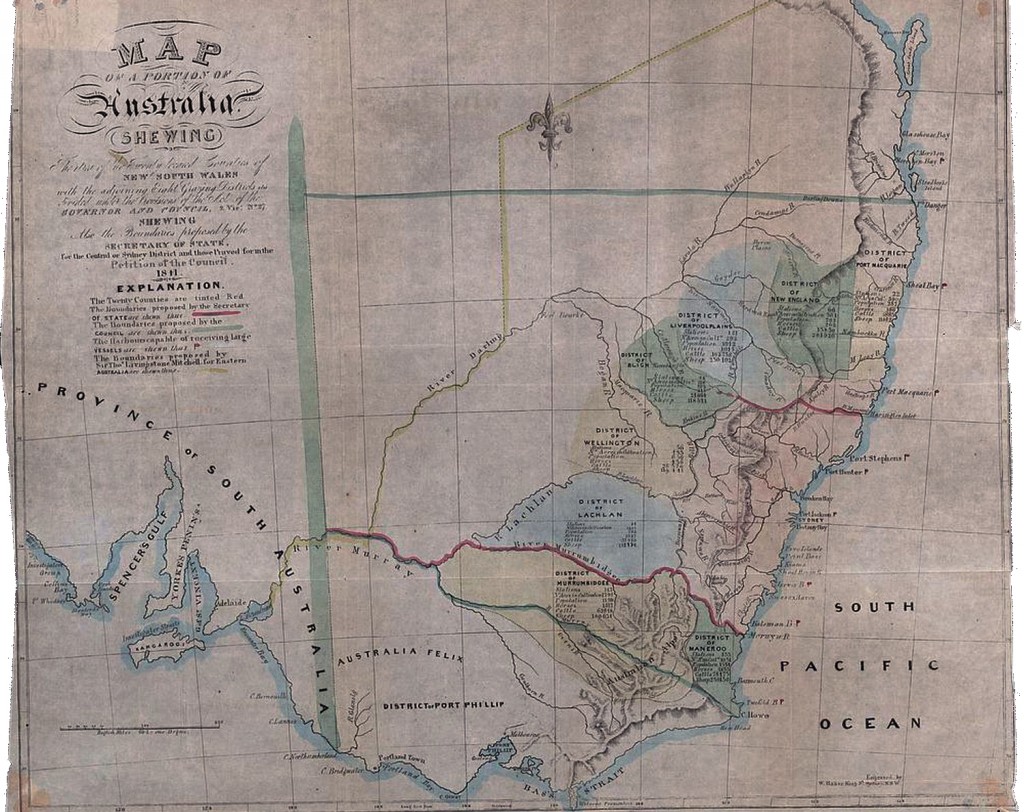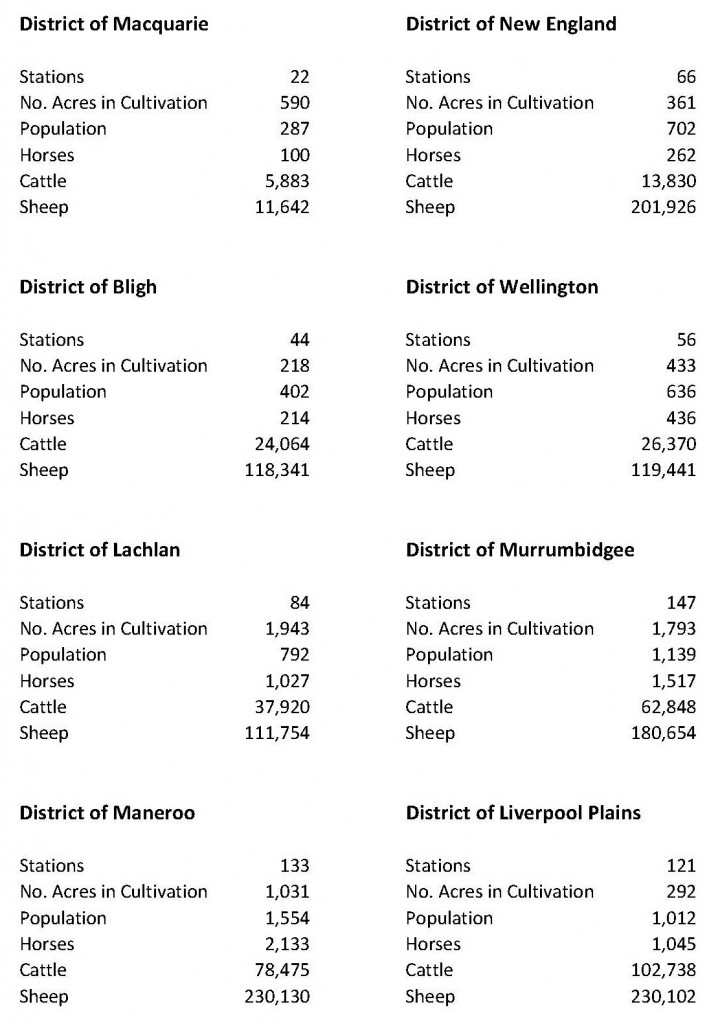The map displaying the colony of New South Wales c 1841 provides a valuable insight into the farming districts that had been established in the new colony in the period of just over first fifty years, since the commencement of the colonisation of Australia.

Map c 1841 – engraved by William Baker, King St, Sydney, NSW
The above map details the location of the districts, the number of runs, population, stock holdings and so forth.
It is interesting to note the names of the times some of which remain until today, others where spellings have changed. It provides an indication as to how quickly the settlers infiltrated the land forging their way through mountains and deserts.
 The settlers were often confronted with conditions that would force them to seek greener pastures.
The settlers were often confronted with conditions that would force them to seek greener pastures.
The following transcript of an article published in the ‘Sydney Morning Herald’ on the 5th October 1846 describes:
“MANEROO.
This district for the want of rain has suffered most severely, and the mortality amongst the sheep and cattle is dreadful. Thousands of sheep have died of the catarrh, and are still dying on some stations, several sheepholders having lost upwards of five thousand. The cattle also are dying by hundreds, one person having lost upwards of a thousand – others in proportion to their stock. The water-holes are nearly all dried up, and choked with dead cattle. The plains literally stink from the dead carcasses. The rain has been plentiful within fifty miles of us, and unless we get some wet soon everything must perish, and the district become abandoned to the crown and native dogs. The crops have been put in; but the seed must perish in the ground for want of moisture. The district is in the most lawless state, there being as many cattle-stealers as licensed settlers. To such a pitch have they got, knowing there is no law or protection for the squatters, one man owning about 90 head of cattle – stolen without doubt – has just started for Twofold Bay with a ton of fat. All the gullies and corners in the ranges are occupied by these vagabonds. Twenty cases might be shown, but it would occupy too much space. Sly grog-selling is also carried on in the district to a great extent; we have no protection whatever, but are at the mercy of the greatest nest of vagabonds the colony ever produced; no police or constable – no bench of magistrates within eighty miles – and no Post Office whereby to make known our distress. If the Government do not place here a sufficient police and constabulary force very soon, the respectable part of the community of this district will be obliged to leave it.”
On a lighter note, the following transcript of an article ‘Destitute State of Maneroo’ published on the 1st August 1845:
“DESTITUTE STATE OF MANEROO.
A squatter from the district of Maneroo has sent us a very fervent address to the young ladies of Sydney, urging them to take pity upon the unfortunate bachelors of Maneroo, who, according to him, are driven to a state of desperation from the paucity of marriageble ladies, and indeed in one verse he darkly insinuates that no young lady ought to cross the border of the counties of St. Vincent or Argyle without being accompanied by her papa and a parson. Our correspondent commences by stating, that Maneroo is a place for snow,
Why this is alluded to we can hardly say, except that “snow” rhymes nicely with “know” which is: – the end of the next line. But as we have no room just now for any long poems, we will at once give the most important verse
There are fifty bachelors besides myself,
Who are pretty well off in the way of pelf,
We all are to marriage much inclined,
If we could get young ladies to our minds.
This is what our friend Stubbs would call “well worthy attention.” Fifty-one bachelors “pretty well off,” are not to be sneezed at; and we think we can hear some of our Sydney belles exclaiming, “why don’t the wretches come to Sydney,” and this is what we say too; but listen to the barbarism. of our correspondent:—
Now young ladies do be kind,
To matrimony make up your minds,
Tell pa to drive you here to see us,
And when you come you cannot leave us.
Now did you ever – No, we are sure you never did, see anything so abominably tantalising as that. The first two lines are well enough, because there are many young ladies who could, without a very great degree of violence to their feelings, “to matrimony make up their minds,” but to suppose that any young lady could ask her pa to drive her to Maneroo (latitude 38 S.), to see fifty-one gentlemen, is rather too absurd — the idea is monstrous. No, if the squatters of Maneroo really wish to secure themselves from the state of single barbarism, in which they describe themselves to be, let them come to Sydney, and go to hear the band on a Thursday, and if they can see all that is to be seen there and escape scatheless, then indeed they must be in a pitiable state. Their appreciation of the beautiful must indeed be dead. But the Maneroo gentlemen must bestir themselves: the ladies can’t look after them; they must look after the ladies.
Ye Southern Squatters, know ye not
That if ye would be wed
The question you must pop.
In the vocabulary of the bush, the season is now approaching when the squatters must procure their “supplies,” and what can you gentlemen squatters supply yourselves with that will afford you as much comfort as a wife. Get wives and fixity of tenure, and instead of being in the barbarous state you are now in, the squatters at Maneroo would be the most glorious set of fellows under the sun — especially while wool remains at two shillings a pound.”
View other important events in Australia’s History . . .
View other important events in New South Wales’ History . . .
